Climate Adaptation Analysis and Comfort Optimization Strategies for Traditional Residential Buildings in Hot-Summer, Cold-Winter Regions: A Case Study in Xuzhou, China
Abstract
:1. Introduction
2. Overview of State of the Art and Background Context
2.1. Research on Building Performance in Hot-Summer, Cold-Winter Areas
2.2. Energy-Saving Retrofit Methods for Buildings in Hot-Summer, Cold-Winter Areas
2.3. Building Optimization Strategies for Hot-Summer, Cold-Winter Regions
2.4. Research Review
3. Methodology
3.1. Research Area
3.2. Village Layout
3.3. Residential Layout
3.3.1. Form
3.3.2. Structure
- 1.
- The wall bases and column bases
- 2.
- Walls
- 3.
- Door and Window Openings
3.3.3. Materials
- 1.
- Raw soil
- 2.
- Lumber
- 3.
- Brick
- 4.
- Stone
4. Field Measurement
4.1. Measurement Objects
4.2. Measurement Setting
4.3. Measurement Results
4.3.1. Physical Environment Measurements in Summer
4.3.2. Physical Environment Measurements in Winter
4.3.3. Measurement Results
5. Software Simulation
5.1. Simulation Method
5.2. Simulation Analysis
5.2.1. Specific Climate Analysis for the Xuzhou Area
5.2.2. Building Heat Gain/Loss Analysis
- 1.
- Architectural parameter settings
- 2.
- Simulation Result Analysis
5.2.3. Wind Environment Simulation
5.3. Energy Model Calibration
5.4. Simulation Results
6. Exploring the Climate Adaptation of Traditional Dwellings
6.1. Village Siting Adaptability
6.2. Residential Adaptability
6.2.1. Individual Buildings
6.2.2. The Courtyard Situation
- 1.
- Climate regulation
- 2.
- Courtyard microenvironment
7. Conclusions and Suggestions
7.1. Conclusions
7.2. Suggestions
Author Contributions
Funding
Institutional Review Board Statement
Informed Consent Statement
Data Availability Statement
Conflicts of Interest
Disclaimer
References
- Wu, X.; He, M.; Cao, S.; Shi, Y. Evolution trend analysis of urban residents’ low-carbon travel development based on multidimensional game theory. J. Cent. South Univ. 2019, 26, 3388–3396. [Google Scholar] [CrossRef]
- Wang, J.; Huang, Y.; Teng, Y.; Yu, B.; Wang, J.; Zhang, H.; Duan, H. Can buildings sector achieve the carbon mitigation ambitiousgoal: Case study for a low-carbon demonstration city in China? Environ. Impact Asses 2021, 90, 106633. [Google Scholar] [CrossRef]
- Wu, Y.; Shen, L.; Shuai, C.; Jiao, L.; Liao, S.; Guo, Z. Key driving forces on the development of low carbon city (LCC) in China. Ecol. Indic. 2021, 124, 107379. [Google Scholar] [CrossRef]
- Zhang, F.; Shi, L.; Liu, S.; Shi, J.; Ma, Q.; Zhang, J. Climate Adaptability Based on Indoor Physical Environment of Traditional Dwelling in North Dong Areas, China. Sustainability 2022, 14, 850. [Google Scholar] [CrossRef]
- Qi, Y.; Stern, N.; He, J.K.; Lu, J.Q.; Liu, T.L.; King, D.; Wu, T. The policy-driven peak and reduction of China’s carbon emissions. Adv. Clim. Change Res. 2020, 11, 65–71. [Google Scholar] [CrossRef]
- Lu, J.; Li, J. Research on the structure of traditional residential energy-saving in hot-summer and cold-winter zone. In Advances in Structural Engineering, Pts 1–3, Proceedings of the International Conference on Civil Engineering and Transportation (ICCET 2011), Jinan, China, 14–16 October 2011; Zhou, X.J., Ed.; Trans Tech Publications: Wollerau, Switzerland, 2011; Volumes 94–96, p. 1378. [Google Scholar]
- Huang, M.Q.; Li, J.H. Analysis on energy-saving path of rural buildings in hot summer and cold winter zone. IOP Conf. Ser. Earth Environ. Sci. 2018, 121, 052096. [Google Scholar] [CrossRef]
- Lei, Z.; Gao, Z.; Zhou, L. Exploitation of Microclimate Diversity and Transitional Space Adaptability focused on the Residence Interior: An Example of the Hot Summer and Cold Winter Zone in China. In Sustainable Cities Development and Environment Protection, Pts 1–3, Proceedings of the 3rd International Conference on Civil Engineering, Architecture and Building Materials (CEABM 2013), Jinan, China, 24–26 May 2013; Xu, N., Tian, L., Dai, F., Eds.; Trans Tech Publications: Wollerau, Switzerland, 2013; Volumes 361–363, pp. 472–475. [Google Scholar]
- Liu, P.; Zhang, Q.; Zhong, K.; Wei, Y.; Wang, Q. Climate Adaptation and Indoor Comfort Improvement Strategies for Buildings in High-Cold Regions: Empirical Study from Ganzi Region, China. Sustainability 2022, 14, 576. [Google Scholar] [CrossRef]
- Li, J.G.; Liu, J.P.; Yang, L. A field study of thermal comfort in residential buildings in winter in the hot-summer and cold-winter climate region. In Proceedings of the Fifth International Workshop on Energy and Environment of Residential Buildings and Third International Conference on Built Environment and Public Health, Volumes I and II, Proceedings, Guilin, China, 29–31 May 2009; pp. 1152–1159. [Google Scholar]
- Zhang, T.; Hu, Q.; Ding, Q.; Zhou, D.; Gao, W.; Fukuda, H. Towards a Rural Revitalization Strategy for the Courtyard Layout of Vernacular Dwellings Based on Regional Adaptability and Outdoor Thermal Performance in the Gully Regions of the Loess Plateau, China. Sustainability 2021, 13, 13074. [Google Scholar] [CrossRef]
- Gong, X.; Li, Y.; Cai, J.; Ma, Z.; He, S.; Pan, B.; Lei, X. A Statistical Analysis of Energy Consumption Survey of Public Buildings in a Hot Summer and Cold Winter Coastal Zone of China. Buildings 2023, 13, 2685. [Google Scholar] [CrossRef]
- Pozas, B.M.; González, F.J. Hygrothermal behaviour and thermal comfort of the vernacular housings in the Jerte Valley (Central System, Spain). Energy Build. 2016, 130, 219–227. [Google Scholar] [CrossRef]
- Tokbolat, S.; Naizabekov, Y.; Mariani, S. The impacts of different facade types on energy use in residential buildings. In Proceedings of the 12th Nordic Symposium on Building Physics (NSB 2020), Tallinn, Estonia, 6–9 September 2020; Volume 172. [Google Scholar]
- Lamrhari, E.D.; Benhamou, B. Thermal behavior and energy saving analysis of a flat with different energy efficiency measures in six climates. Build. Simul. 2018, 11, 1123–1144. [Google Scholar] [CrossRef]
- Luka, P.; Jaka, P.; Mitja, K. The effect of a warming climate on the relevance of passive design measures for heating and cooling of European single-family detached buildings. Energy Build. 2022, 261, 111947. [Google Scholar]
- Zhong, J.; Zhang, X.; Yang, Y. Thermodynamic Renovations in Traditional Huizhou Folk Dwellings: A Case Study. Int. J. Heat Technol. 2023, 41, 937–946. [Google Scholar] [CrossRef]
- Shi, F.; Yu, Z. Study on Thermal Behavior of an Experimental Low-energy Building in the Hot Summer and Cold Winter Zone of China. J. Asian Arch. Build. 2016, 15, 503–510. [Google Scholar] [CrossRef]
- Wei, N.; Zheng, W.X.; Zhang, N.; Zhao, S.K.; Zhai, Y.C.; Yang, L. Field study of seasonal thermal comfort and adaptive behavior for occupants in residential buildings of Xi’an, China. J. Cent. South Univ. 2022, 29, 2403–2414. [Google Scholar] [CrossRef]
- Steffen, L.; Ken, Y. Meeting with the Green Urban Planner: A Conversation Between Ken Yeang and Steffen Lehmann on Eco-Masterplanning for Green Cities. J. Green Build. 2010, 5, 36–40. [Google Scholar]
- Lamberti, G.; Contrada, F.; Kindinis, A. Exploring adaptive strategies to cope with climate change: The case study of Le Corbusier’s Modern Architecture retrofitting. Energy Build. 2024, 302, 113756. [Google Scholar] [CrossRef]
- Harkouss, F.; Fardoun, F.; Biwole, P.H. Passive design optimization of low energy buildings in different climates. Energy 2018, 165, 591–613. [Google Scholar]
- Van Ellen, L.A.; Bridgens, B.N.; Burford, N.; Heidrich, O. Rhythmic Buildings- a framework for sustainable adaptable architecture. Build. Environ. 2021, 203, 108068. [Google Scholar] [CrossRef]
- Li, B.; Yu, W.; Liu, M.; Li, N. Climatic Strategies of Indoor Thermal Environment for Residential Buildings in Yangtze River Region, China. Indoor Built. Environ. 2011, 20, 101–111. [Google Scholar]
- Hao, F.Y.; Tao, Y.Z.; Jiang, L.; Xu, X. Optimum insulation thickness of external walls by integrating indoor moisture buffering effect: A case study in the hot-summer-cold-winter zone of China. J. Zhejiang Univ.-Sci. A 2023, 23, 998–1012. [Google Scholar]
- Jiang, D.M.; Shan, J.D.; Ji, L.J. Research on the impact of external window performance on energy consumption of residential buildings in hot summer and cold winter regions. Jiangsu Build. 2018, S1, 115–118. [Google Scholar]
- Li, M.; Tang, H.X. An experimental study of Lu Yuan-ding’s view of traditional Chinese residential architecture. New Archit. 2019, 5, 123–127. [Google Scholar]
- Huo, H.; Deng, X.; Wei, Y.; Liu, Z.; Liu, M.; Tang, L. Optimization of energy-saving renovation technology for existing buildings in a hot summer and cold winter area. J. Build. Eng. 2024, 86, 108597. [Google Scholar] [CrossRef]
- Zeng, Z.W.; Li, L.; Pang, Y. Analysis on climate adaptability of traditional villages in Lingnan, China-World Cultural Heritage Site of Majianglong Villages as example. In Proceedings of the 10th International Symposium on Heating, Ventilation and Air Conditioning, ISHVAC2017, Jinan, China,, 9–22 October 2017; Volume 205, pp. 2011–2018. [Google Scholar]
- Min, T.Y.; Zhang, T. Study on the Climate Adaptability of Architectural Interface Opening in Suzhou’s Regional Residences. In Proceedings of the 4th International Conference on Countermeasures to Urban Heat Island, (UHI 2016), Singapore, 30 May–4 June 2016; Wong, N.H., Jusuf, S.K., Eds.; Volume 169, pp. 108–116. [Google Scholar]
- Xu, J.; Lu, Z.L.; Gao, W.J.; Yang, M.S.; Su, M.L. The comparative study on the climate adaptability based on indoor physical environment of traditional dwelling in Qinba mountainous areas, China. Energy Build. 2019, 197, 140–155. [Google Scholar]
- Mohammadi, A.; Saghafi, M.R.; Tahbaz, M.; Nasrollahi, F. The study of climate-responsive solutions in traditional dwellings of Bushehr City in Southern Iran. J. Build. Eng. 2018, 16, 169–183. [Google Scholar]
- Indraganti, M. Understanding the climate sensitive architecture of Marikal, a village in Telangana region in Andhra Pradesh, India. Build. Environ. 2010, 45, 2709–2722. [Google Scholar] [CrossRef]
- Huang, L.J.; Lan, B. From locality to sustainability: The development and inspiration of climate adaptation research on foreign vernacular architecture. J. Archit. 2011, S1, 103–107. [Google Scholar]
- Zhang, H.; Zheng, L.H. Microclimate simulation of residential landscape design based on Ecotect and Phoenics. Shanxi Archit. 2014, 40, 10–12. [Google Scholar]
- Sadat, N. Assessing Thermal Performance of Mud House Using ECOTECT Analysis—A Case of Vernacular Architecture in Northern Bangladesh. Am. Acad. Sci. Res. J. Eng. Technol. Sci. 2021, 79, 79–87. [Google Scholar]
- Shang, Y. PHOENICS-based Simulation Study on Winter Wind Environment in Outdoor Space of Old Communities—Taking Sanlihe Community of Beijing as An Example. IOP Conf. Ser. Earth Environ. Sci. 2020, 560, 012064. [Google Scholar] [CrossRef]
- Lu, X.; Li, H.M.; Ding, B.; Chen, Y.Y. Climate coping strategies for traditional residential houses in hot summer and cold winter transition areas: An empirical analysis based on the Yu Family Residence in Hube Mountain, Xuzhou. Jiangsu Arch. 2017, 5, 107–112. [Google Scholar]
- Wang, Q.W. Research on Climate Adaptation of Traditional Vernacular Houses in Northern Jiangsu Province. Master’s Thesis, Shanghai Jiao Tong University, Shanghai, China, 2009. [Google Scholar]
- Zhang, D.; Shi, Z.; Cheng, M. A Study on the Spatial Pattern of Traditional Villages from the Perspective of Courtyard House Distribution. Buildings 2023, 13, 1913. [Google Scholar] [CrossRef]
- Bermuda Training. Autodesk Ecotect Analysis 2011 Green Building Analysis Examples; China Construction Industry Press: Beijing, China, 2011. [Google Scholar]
- Sun, L.; Ding, S.H. Research on Building Layout of Xuzhou Mining Residential Area Based on Wind Environment Simulation. J. Shenyang Archit. Univ. Soc. Sci. Ed. 2017, 19, 109–115. [Google Scholar]
- Jhumka, H.; Yang, S.; Gorse, C.; Wilkinson, S.; Yang, R.; He, B.; Prasad, D.; Fiorito, F. Assessing heat transfer characteristics of building envelope deployed BIPV and resultant building energy consumption in a tropical climate. Energy Build. 2023, 298, 113540. [Google Scholar] [CrossRef]
- Judkoff, R. Measurement of Energy, Demand, and Water Savings: ASHRAE Guideline 14-2014 [S]; American Society of Heating, Refrigerating and Air-Conditioning Engineers: Atlanta, GA, USA, 2014. [Google Scholar]
- Yang, S. Studies on the Performances of Building Integrated Photovoltaic/Thermal Double-Skin Facade for Commercial Buildings in Australia, in School of Built Environment. Ph.D. Thesis, University of New South Wales, Sydney, Australia, 2020; 299p. [Google Scholar]
- Huang, M.P. Shallow analysis of architectural feng shui. Fujian Constr. Sci. Technol. 2015, 2, 51–53. [Google Scholar]
- Wang, H.U. Temporal analysis of natural disasters in Xuzhou. Cai Zhi 2018, 23, 243–244. [Google Scholar]
- Hassan, A.; Moradi, C.S.; Hamidi, M.N.; Masa, N. Effect of courtyards’ geometrical parameters on climate adaptability and shading performance in hot-arid climate of Yazd (Iran). Sustain. Energy Technol. 2021, 48, 101594. [Google Scholar]







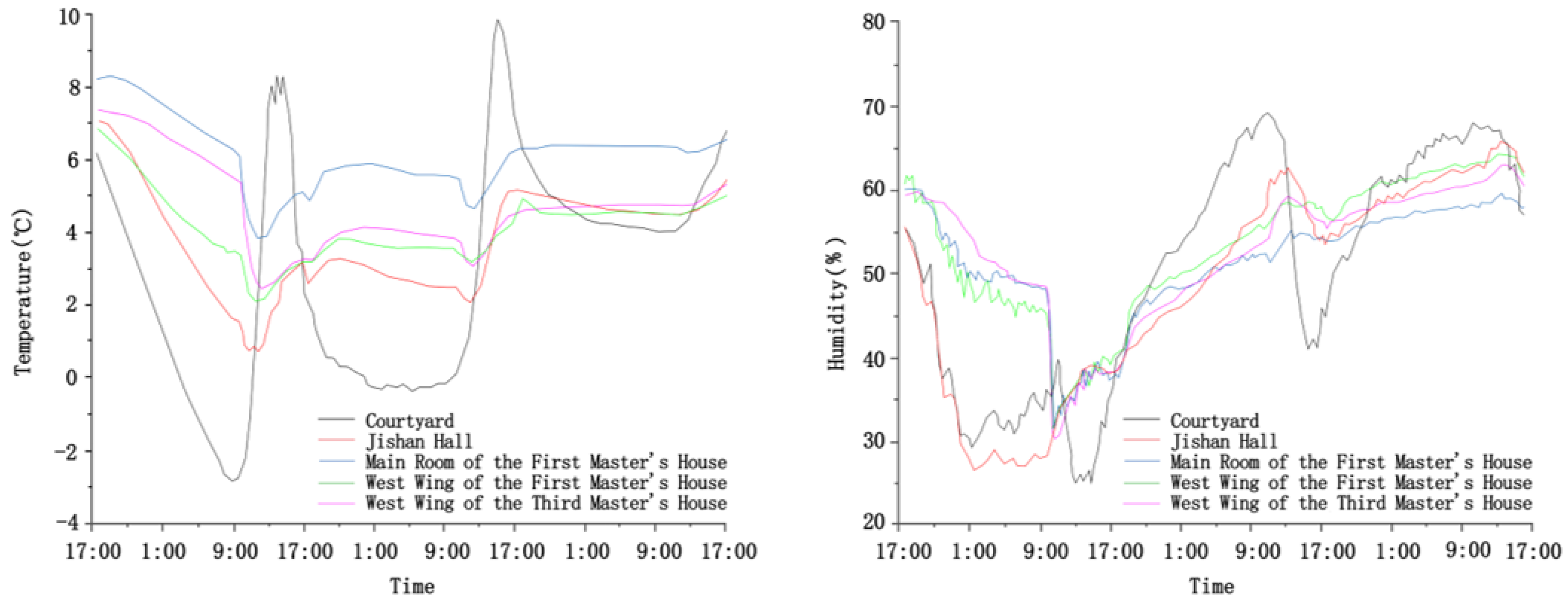
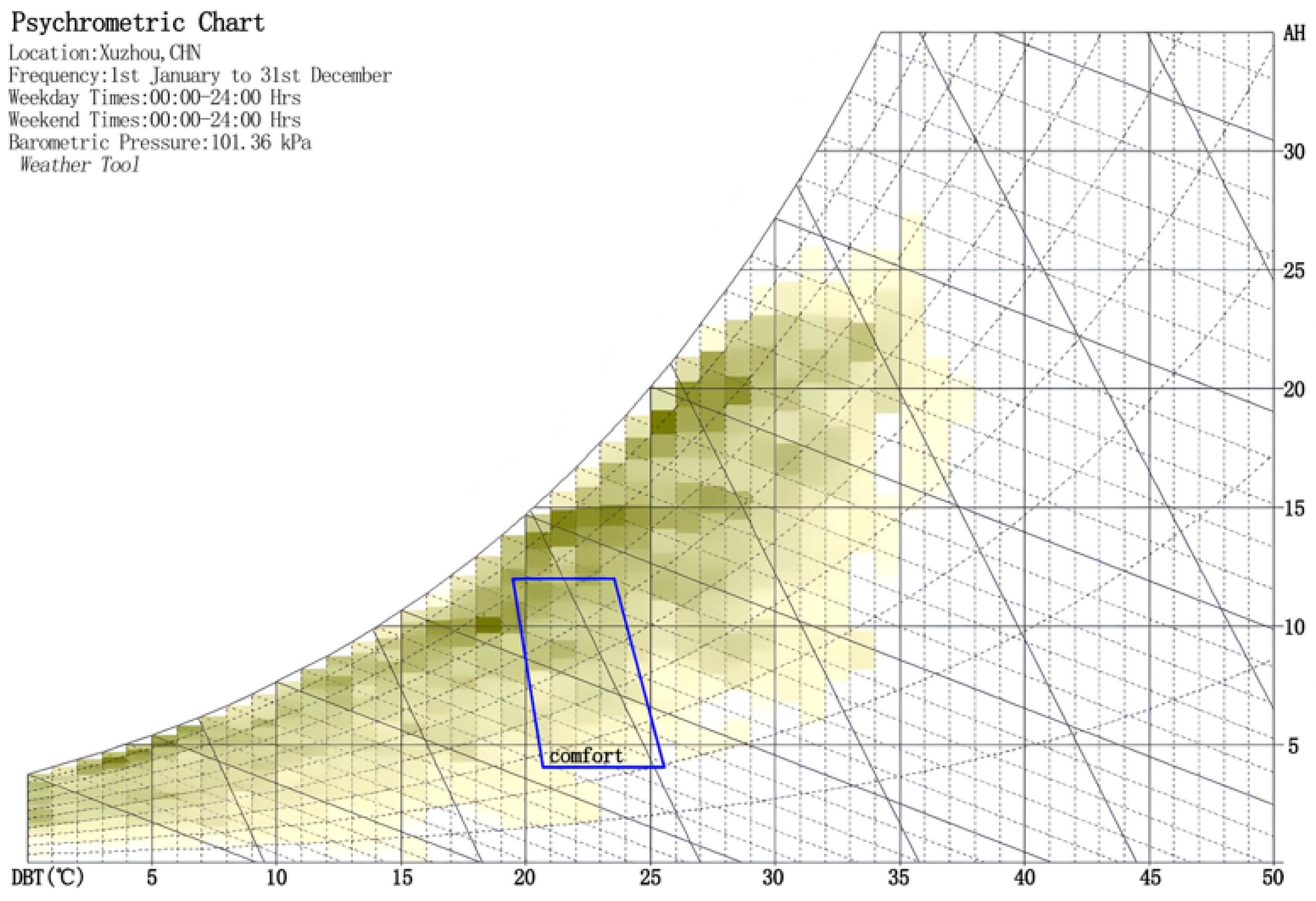


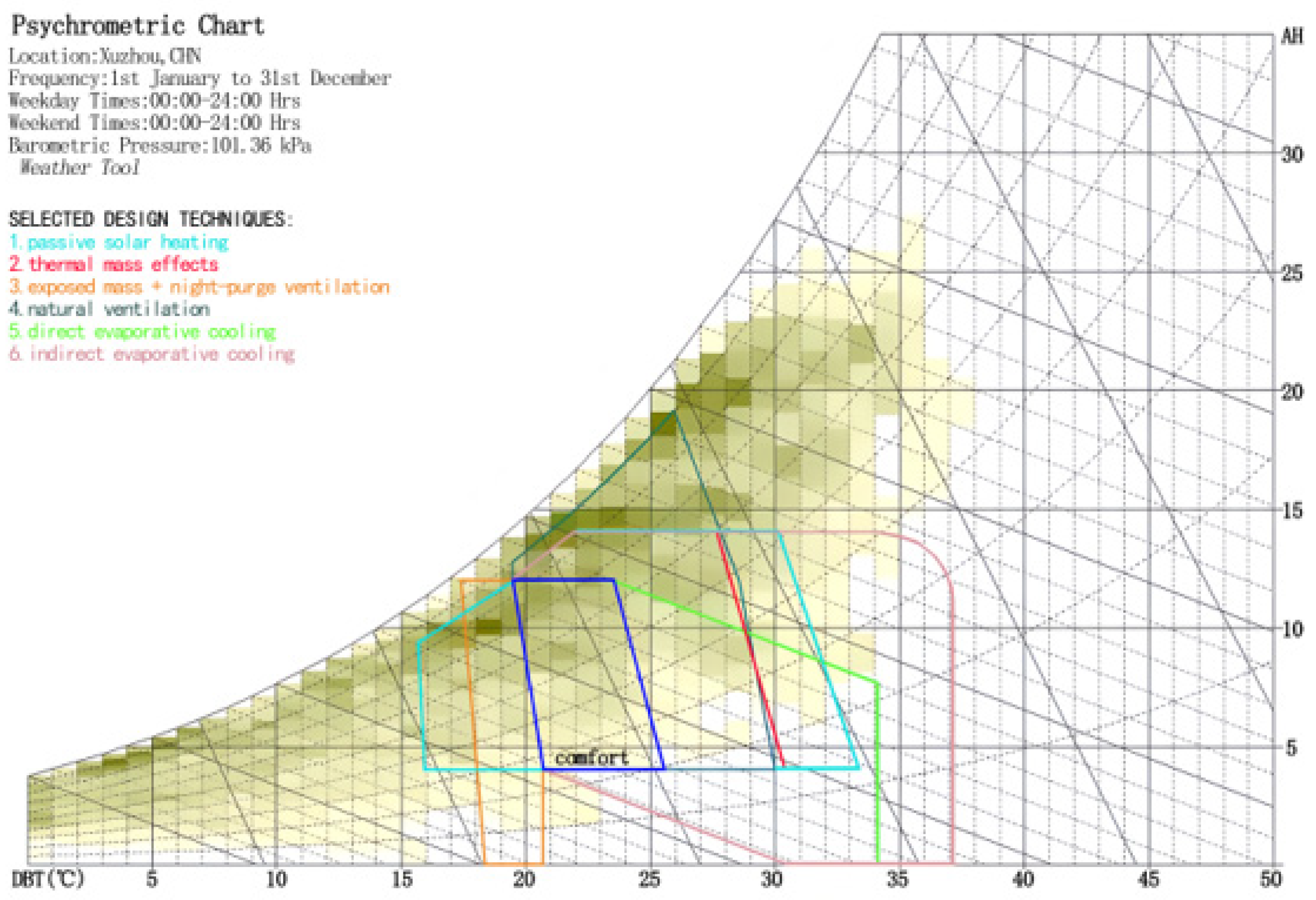
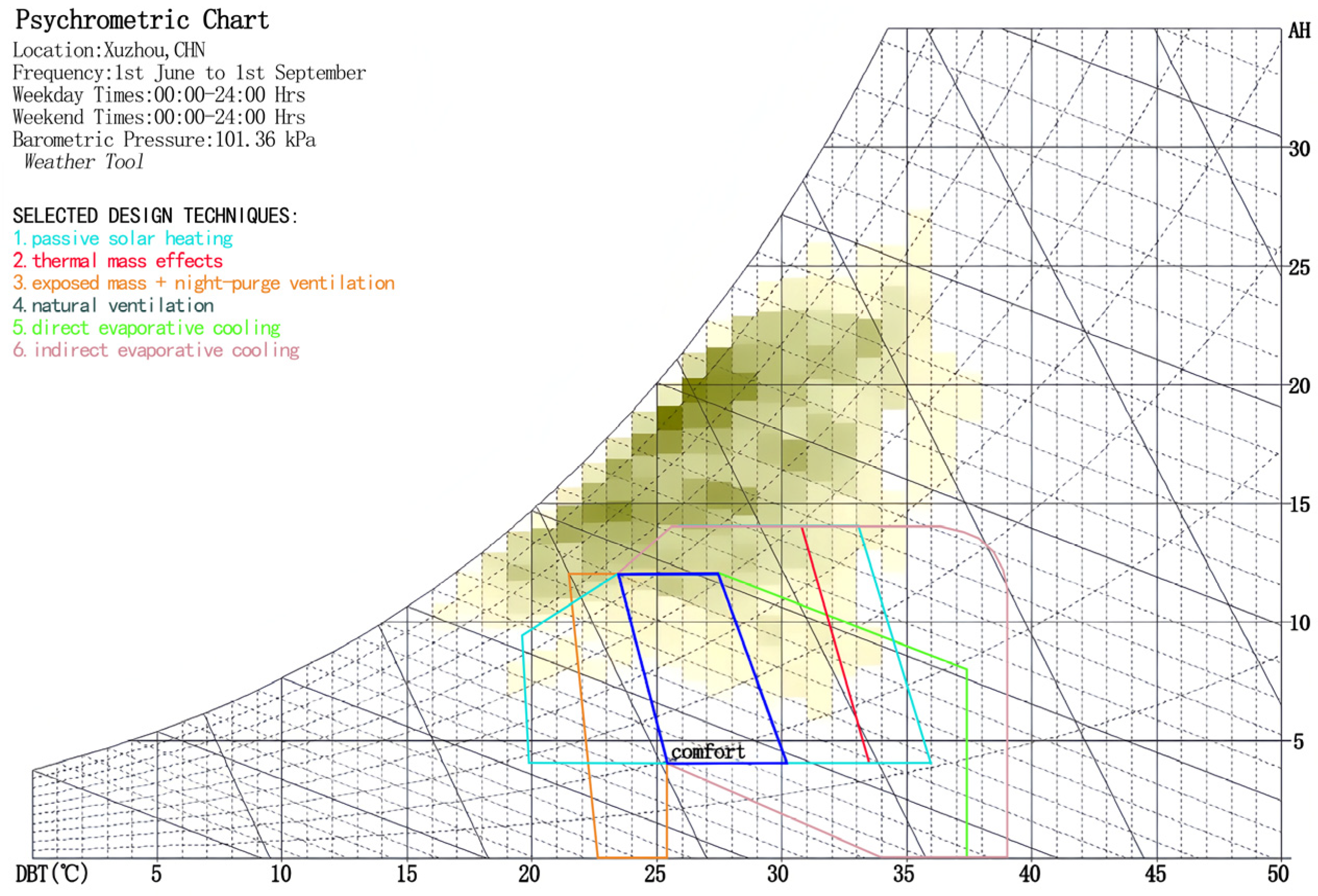




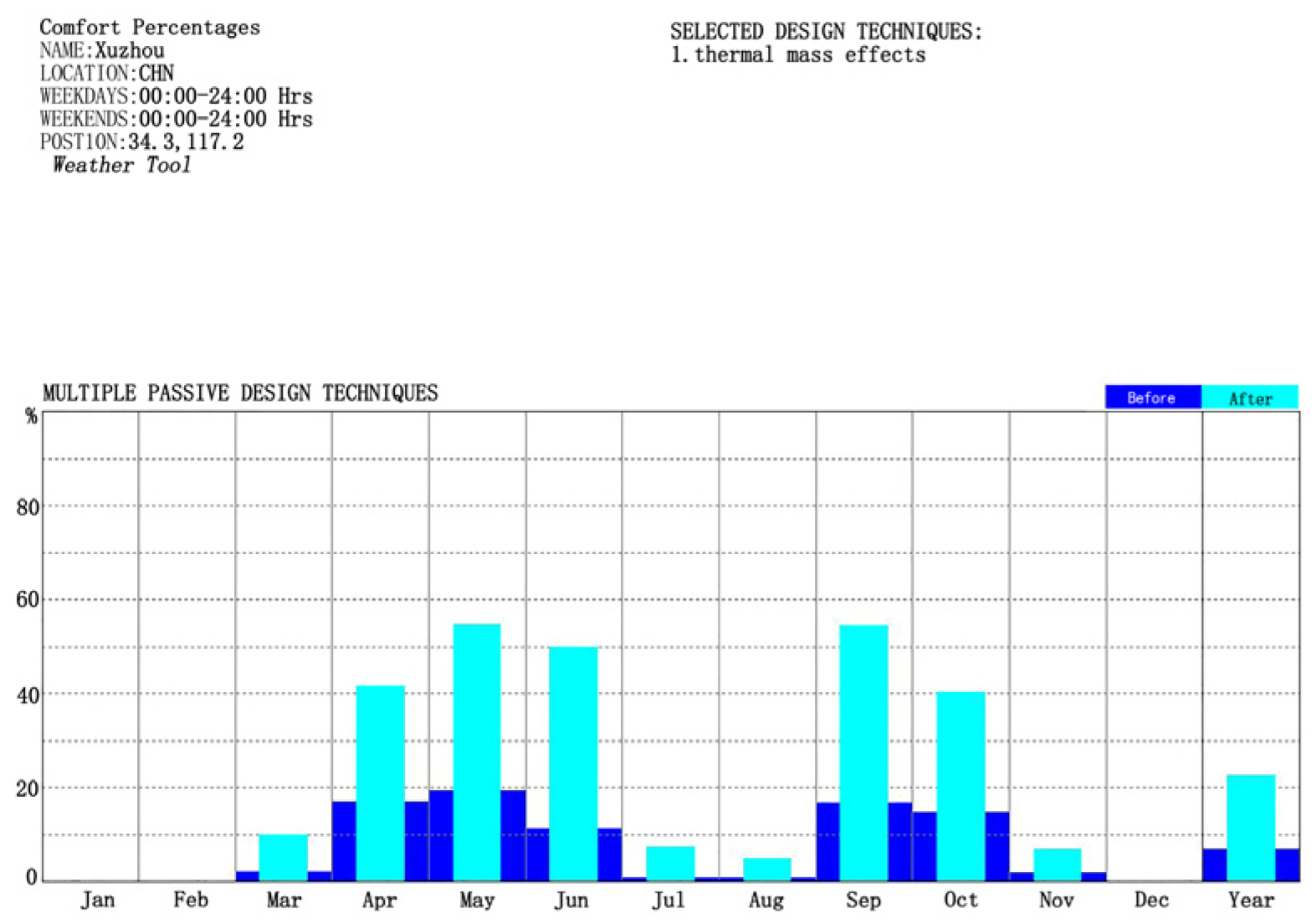

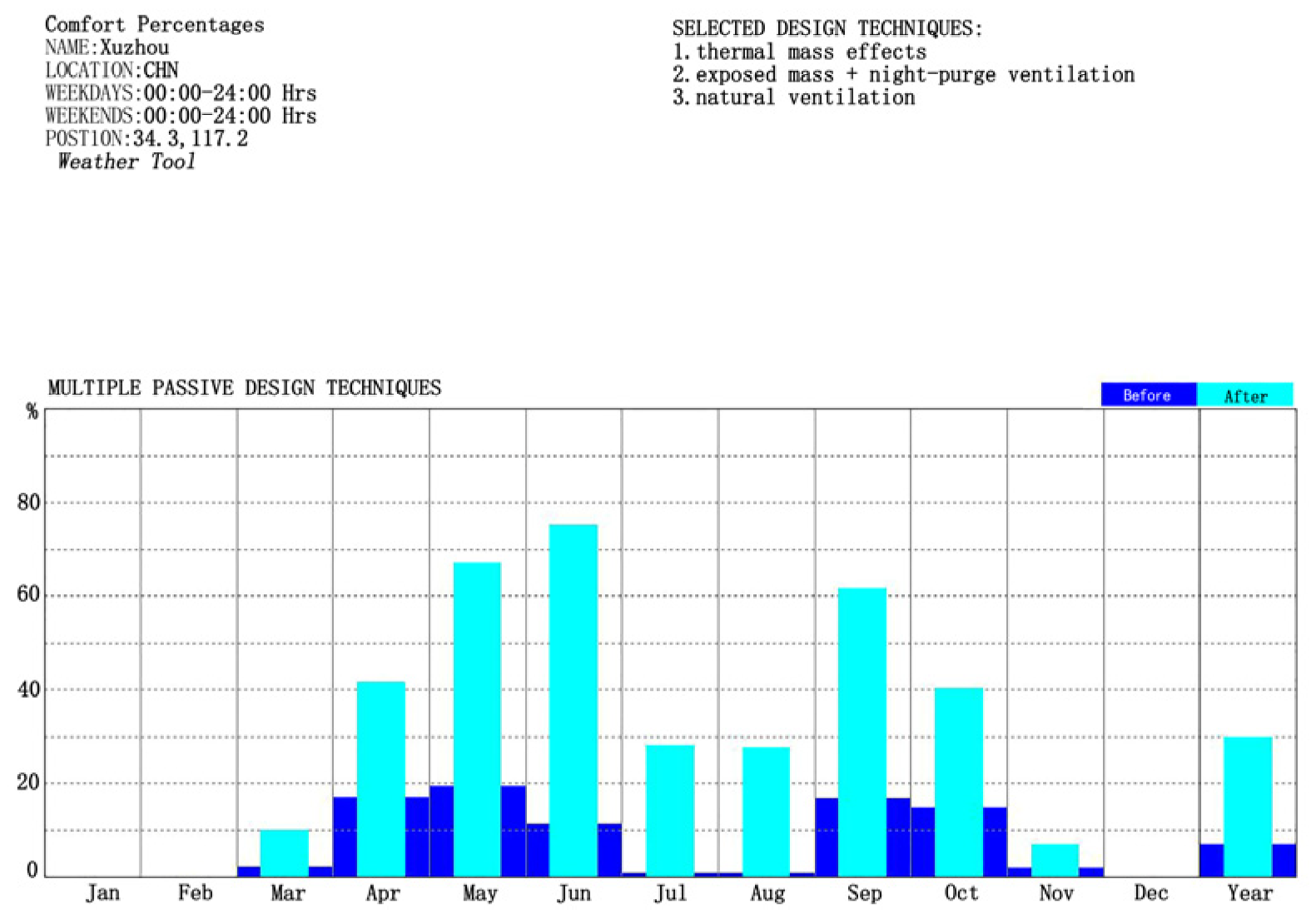







| Typology | Advantage | Disadvantage |
|---|---|---|
| Raw soil | Good thermal insulation, recyclable, easy to use local materials | Poor waterproofing, easily deformed in water |
| Lumber | Low thermal conductivity | Corrodes easily |
| Brick | Harder, locally sourced | Poor waterproofing |
| Stone | Harder and more waterproof | Poor ventilation |
| Name of Instrument | Measuring Parameter | Measuring Range and Accuracy | Instrument Picture | Operating Method |
|---|---|---|---|---|
| Tinytag Internal Temperature Relative Humidity | Temperature and humidity | Temperature measurement range: −25~85; Humidity measurement range: 0~100% RH |  | Continuous automatic recording every 5 min, day and night. |
| MODEL 6006 Handheld Thermal Anemometer | Indoor and outdoor wind speed test | Range:0.01~20.0 m/s (20~3940 PM); Accuracy: ±5% of indicated value or 0.015 m/s (+2 FPM); Resolution: 0.01 m/s |  | Manual recording, averaged every five minutes. |
| Timing | Typology | Courtyard | Jishan Hall | West Wing of the First Master’s House | West Wing of the First Master’s House | West Wing of the Third Master’s House |
|---|---|---|---|---|---|---|
| 06.30 | Maximum temperature (°C) Date of occurrence | 35.10 11:55 | 32.15 15:55 | 29.76 15:55 | 29.57 15:35 | 29.80 15:55 |
| 07.01 | Maximum temperature (°C) Date of occurrence | 36.83 12:55 | 31.67 16:55 | 28.69 16:35 | 29.60 13:35 | 29.79 16:35 |
| 07.02 | Maximum temperature (°C) Date of occurrence | 38.49 14:55 | 32.85 16:35 | 29.64 19:55 | 30.91 16:35 | 30.26 16:35 |
| 07.03 | Maximum temperature (°C) Date of occurrence | 34.89 11:55 | 31.89 12:55 | 30.23 13:55 | 32.68 13:35 | 32.44 13:35 |
| Courtyard | Jishan Hall | Main Room of the First Master’s House | West Wing of the First Master’s House | West Wing of the Third Master’s House | |
|---|---|---|---|---|---|
| Average wind speed (m/s) | 0.30 | 0.19 | 0.10 | 0.11 | 0.12 |
| Maximum wind speed (m/s) | 1.75 | 1.08 | 0.51 | 0.61 | 0.49 |
| Timing | Typology | Courtyard | Jishan Hall | West Wing of the First Master’s House | West Wing of the First Master’s House | West Wing of the Third Master’s House |
|---|---|---|---|---|---|---|
| 12.31 | Maximum temperature (°C) Date of occurrence | 8.92 13:15 | 6.55 14:45 | 8.13 18:55 | 5.48 15:45 | 7.21 16:10 |
| 01.01 | Maximum temperature (°C) Date of occurrence | 10.49 13:00 | 5.34 15:35 | 6.97 18:20 | 5.73 15:40 | 5.14 16:40 |
| 01.02 | Maximum temperature (°C) Date of occurrence | 7.59 14:30 | 6.24 16:50 | 7.57 17:45 | 5.78 16:50 | 6.02 16:50 |
| Courtyard | Jishan Hall | Main Room of the First Master’s House | West Wing of the First Master’s House | West Wing of the Third Master’s House | |
|---|---|---|---|---|---|
| Average wind speed (m/s) | 0.28 | 0.15 | 0.09 | 0.10 | 0.10 |
| Maximum wind speed (m/s) | 1.06 | 0.52 | 0.31 | 0.35 | 0.34 |
| Category | Composition | Thicknesses (mm) | Density (kg/m3) | Thermal Conductivity (W/(Mk)) | Specific Heat (J/(kgK)) |
|---|---|---|---|---|---|
| Roof | Roof tile | 30 | 2000 | 0.75 | 1240 |
| Plaster 1 | 40 | 1400 | 0.58 | 1010 | |
| Plaster 2 | 80 | 1800 | 0.62 | 1010 | |
| White ash | 20 | 1250 | 0.43 | 1088 | |
| Brick | 25 | 2000 | 0.75 | 1240 | |
| Wall | Plastering layer | 10 | 1600 | 0.81 | 1050 |
| Green brick | 126 | 2000 | 0.75 | 1240 | |
| Layer of broken bricks | 442 | 2000 | 0.66 | 1240 | |
| Green brick | 126 | 2000 | 0.75 | 1240 | |
| Hill wall (above) | Plastering layer | 10 | 1600 | 0.81 | 1050 |
| Green brick | 126 | 2000 | 0.75 | 1240 | |
| Layer of broken bricks | 442 | 2000 | 0.66 | 1240 | |
| Green brick | 126 | 2000 | 0.75 | 1240 | |
| Hill wall (lower) | Plastering layer | 10 | 1600 | 0.81 | 1050 |
| Limestone | 704 | 2400 | 2.04 | 924 | |
| Partitions | Fir | 40 | 500 | 0.12 | 2510 |
| Floor | Rectangular tile | 40 | 2000 | 0.75 | 1240 |
| Category | Composition | Thicknesses (mm) | Density (kg/m3) | Thermal Conductivity (W/(mK)) | Specific Heat (J/(kgK)) |
|---|---|---|---|---|---|
| Roof | Roof tile | 30 | 2000 | 0.75 | 1240 |
| Plaster 1 | 40 | 1400 | 0.58 | 1010 | |
| Plaster 2 | 80 | 1800 | 0.62 | 1010 | |
| White ash | 20 | 1250 | 0.43 | 1088 | |
| Brick | 25 | 2000 | 0.75 | 1240 | |
| Wall | Plastering layer | 10 | 1600 | 0.81 | 1050 |
| Green brick | 126 | 2000 | 0.75 | 1240 | |
| Middle layer | 248 | 2000 | 0.66 | 1240 | |
| Green brick | 126 | 2000 | 0.75 | 1240 | |
| South wall | Fir floor door | 40 | 500 | 0.29 | 2510 |
| Partition | Fir | 40 | 500 | 0.29 | 2510 |
| Floor | Rectangular tile | 40 | 2000 | 0.75 | 1240 |
| Category | Composition | Thicknesses (mm) | Density (kg/m3) | Thermal Conductivity (W/(mK)) | Specific Heat (J/(kgK)) |
|---|---|---|---|---|---|
| Roof | Roof tile | 30 | 2000 | 0.75 | 1240 |
| Plaster 1 | 40 | 1400 | 0.58 | 1010 | |
| Plaster 2 | 80 | 1800 | 0.62 | 1010 | |
| White ash | 20 | 1250 | 0.43 | 1088 | |
| Brick | 25 | 2000 | 0.75 | 1240 | |
| Wall | Plastering layer | 10 | 1600 | 0.81 | 1088 |
| Green brick | 126 | 2000 | 0.75 | 1240 | |
| Layer of broken bricks | 420 | 2000 | 0.66 | 1240 | |
| Green brick | 126 | 2000 | 0.75 | 1240 | |
| Hill wall (above) | Plastering layer | 10 | 1600 | 0.43 | 1088 |
| Green brick | 126 | 2000 | 0.75 | 1240 | |
| Layer of broken bricks | 318 | 2000 | 0.66 | 1240 | |
| Green brick | 126 | 2000 | 0.75 | 1240 | |
| Plastering layer | 10 | 1600 | 0.43 | 1088 | |
| Hill wall (lower) | Limestone | 0 | 2400 | 2.04 | 924 |
| Floor | Rectangular tile | 40 | 2000 | 0.75 | 1240 |
| Category | Composition | Thicknesses (mm) | Density (kg/m3) | Thermal Conductivity (W/(mK)) | Specific Heat (J/(kgK)) |
|---|---|---|---|---|---|
| Roof | Roof tile | 30 | 2000 | 0.75 | 1240 |
| Plaster 1 | 40 | 1400 | 0.58 | 1010 | |
| Plaster 2 | 80 | 1800 | 0.62 | 1010 | |
| White ash | 20 | 1250 | 0.43 | 1088 | |
| Brick | 25 | 2000 | 0.75 | 1240 | |
| Wall | Plastering layer | 10 | 1600 | 0.81 | 1088 |
| Green brick | 126 | 2000 | 0.75 | 1240 | |
| Adobe brick | 1800 | 0.52 | 1800 | ||
| Green brick | 126 | 2000 | 0.75 | 1240 | |
| Hill wall (above) | Plastering layer | 10 | 1250 | 0.43 | 1088 |
| Green brick | 126 | 2000 | 0.75 | 1240 | |
| Adobe brick | 308 | 1800 | 0.47 | 1800 | |
| Green brick | 126 | 2000 | 0.75 | 1240 | |
| Plastering layer | 10 | 1250 | 0.43 | 1088 | |
| Hill wall (lower) | Limestone | 0 | 2400 | 2.04 | 924 |
| Floor | Rectangular tile | 40 | 2000 | 0.75 | 1240 |
| Building Type | Timing | Enclosure Heat Transfer (J) | Heat Gain from Solar Radiation (J) | Heat Exchange Due to Air Infiltration (J) | Internal Disturbance Caused by Heat (TCM) (J) | Inter-Area Heat Transfer (J) |
|---|---|---|---|---|---|---|
| Jishan Hall | Coldest day | −15,634 | 1873 | −101,245 | 3360 | 12,600 |
| Hottest day | 9844 | 972 | 17,657 | 3360 | −10,832 | |
| The main room of the First Master’s House | Coldest day | −79,913 | 4779 | −34,500 | 11,907 | 7998 |
| Hottest day | 36,573 | 2959 | 7697 | 11,907 | −8176 | |
| The west wing of the First Master’s House | Coldest day | 29,669 | 1152 | 4867 | 9165 | −39,007 |
| Hottest day | −837,736 | 1374 | −21,814 | 9165 | 35,494 | |
| The West Wing of the Third Master’s House | Coldest day | −84,670 | 1093 | −22,742 | 9119 | 5396 |
| Hottest day | 28,832 | 1366 | 5074 | 9119 | −5535 |
| Indices | Jan | Feb | Mar | Apr | May | Jun | Jul | Aug | Sep | Oct | Nov | Dec |
|---|---|---|---|---|---|---|---|---|---|---|---|---|
| NMBE | 3% | 2% | 4% | 3% | −1% | −3% | −4% | −3% | −5% | −2% | 1% | 2% |
| CV(RMSE) | 8% | 6% | 10% | 9% | 2% | 7% | 11% | 9% | 13% | 5% | 3% | 4% |
Disclaimer/Publisher’s Note: The statements, opinions and data contained in all publications are solely those of the individual author(s) and contributor(s) and not of MDPI and/or the editor(s). MDPI and/or the editor(s) disclaim responsibility for any injury to people or property resulting from any ideas, methods, instructions or products referred to in the content. |
© 2024 by the authors. Licensee MDPI, Basel, Switzerland. This article is an open access article distributed under the terms and conditions of the Creative Commons Attribution (CC BY) license (https://creativecommons.org/licenses/by/4.0/).
Share and Cite
Zhang, M.; Liu, F.; Liu, Q.; Zhang, F.; Li, T. Climate Adaptation Analysis and Comfort Optimization Strategies for Traditional Residential Buildings in Hot-Summer, Cold-Winter Regions: A Case Study in Xuzhou, China. Sustainability 2024, 16, 3411. https://doi.org/10.3390/su16083411
Zhang M, Liu F, Liu Q, Zhang F, Li T. Climate Adaptation Analysis and Comfort Optimization Strategies for Traditional Residential Buildings in Hot-Summer, Cold-Winter Regions: A Case Study in Xuzhou, China. Sustainability. 2024; 16(8):3411. https://doi.org/10.3390/su16083411
Chicago/Turabian StyleZhang, Minghao, Fang Liu, Qian Liu, Fangyu Zhang, and Tingshen Li. 2024. "Climate Adaptation Analysis and Comfort Optimization Strategies for Traditional Residential Buildings in Hot-Summer, Cold-Winter Regions: A Case Study in Xuzhou, China" Sustainability 16, no. 8: 3411. https://doi.org/10.3390/su16083411




